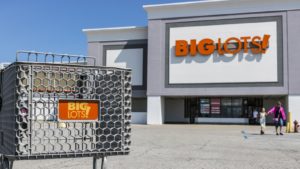
Identifying potential risks before they materialize into financial downturns is a must-have skill in the stock market. As the market shifts and companies face adversities, a vigilant eye on potential pitfalls is needed. Here is a dissection of the vulnerabilities of three prominent stocks.
The first one, a retail giant, grapples with declining sales in vital categories, countering fierce competition in the bargain-oriented market. Meanwhile, the second one targets the stars but needs help scaling production, potentially dampening its valuation growth. Finally, disrupting the automotive retail sector, the third delivered a sequential decline in retail units sold, hinting at adversity in sustaining performance growth.
Amidst these issues, investors can avoid potential avalanches of these stocks’ price collapses before they occur. Knowing the fundamentals behind these companies’ weaknesses, they can strategically position themselves in turbulent times.
Big Lots (BIG)

Big Lots’ (NYSE:BIG) sales performance, competitive pressure, and a shift towards a bargain-oriented assortment are critical weakness factors that breed the potential valuation deterioration.
For instance, in Q3, Big Lots experienced declines in several categories. The furniture, soft home, and hard home categories each saw double-digit decreases in sales. Furniture sales did show improvement in Q4 to date, which is encouraging. However, the company faced adversities due to disruptions caused by the closure of a major furniture vendor and difficulties in procuring optimal assortments. The decline in these categories has impacted overall sales performance, contributing to the negative comparable sales figure of 13.2% in Q3.
Additionally, the food and consumables category presented adversity for Big Lots. The company admitted the need to be more aggressive in offering bargains in highly competitive categories, which resulted in missed opportunities. It did make efforts to optimize and reset the consumables assortment, particularly in personal care categories. Yet, BIG already acknowledged the need to accelerate the penetration of extreme bargains in the food category. This will enable them to better compete with leading price retailers and grocery stores.
Moreover, Big Lots has been trying to transition its assortment towards offering more bargains, products priced significantly below most retailers’ prices. The company aimed to have over one-third of its assortment comprised of bargains in 2023. However, it exceeded this goal, with nearly 50% of sales coming from bargains in Q3. The goal is that this shift can attract value-conscious customers. Yet, this also indicates that a significant portion of the product mix relies on closeouts and opportunistic buys. Therefore, this may not provide consistent availability or long-term sustainability in certain categories.
Virgin Galactic (SPCE)

Virgin Galactic (NYSE:SPCE) targets to achieve a high flight rate with each Delta spaceship, generating revenue per flight of $3.6 million at current pricing levels. But, concerns exist regarding scaling production efficiently and managing costs. Using aerospace industry expert suppliers for major subassemblies suggests a heavy reliance on external partners. And it could mean potential complexities in managing the supply chain.
The flight data indicates that Virgin Galactic operates at a relatively low flight rate, with only six flights conducted in 2023. A low flight rate limits revenue generation potential and leads to underutilization of fleet assets. This results in suboptimal financial performance and a slower growth trajectory. Similarly, Virgin Galactic’s Delta-class spaceships have a capacity of six astronauts (in addition to two pilots). That is a 50% increase in seating capacity compared to the previous Unity spaceship.
However, even with this increased capacity, the company has yet to fully leverage its fleet’s flexibility. This leads to suboptimal capacity utilization. In detail, the company has brought only 24 people to space since May 2023, for a total of 32 astronauts flown to date. Hence, this utilization rate significantly lies below the fleet’s capacity potential.
Furthermore, Virgin Galactic emphasizes its transition from R&D and prototype roots to manufacturing and operational phases. However, such transitions often entail inherent risks and uncertainties, including resource allocation, technology integration, and operational scalability. Meanwhile, Virgin Galactic forecasts attractive returns on growth capital investments (CapEx of $40 million to $45 million in Q1 2024).
Likewise, the company projects securing additional funding for fleet expansion and infrastructure development, which seems unrealistic considering the current performance. Therefore, the company relies on external financing sources, including equity offerings and debt financing, which exposes it to ongoing market volatility.
Carvana (CVNA)

For Carvana (NYSE:CVNA), sequential declines in retail units sold and top-line to bottom-line performance hinder the company’s valuation growth potential. For instance, in Q4 2023, Carvana experienced a sequential % decline in retail units sold by 6%. While this decline was in line with the company’s outlook, it is real damage after all. This signifies a decrease in sales volume. Similarly, Q4 revenue amounted to $2.424 billion, indicating a sequential decrease of 13%. This decline in revenue shows the impact of the reduction in retail units sold.
Fundamentally, the decline in retail units sold and total revenue suggests a potential weakness in Carvana’s fundamental capability to hold constant growth in sales volume. Despite being in line with expectations, any further decline in sales volume could hinder the company’s ability to expand its market share, top-line, and market cap.
Towards the bottom-line, non-GAAP total gross profit per unit (GPU) in Q4 was $5,730, reflecting a decrease of $666 in Q3 2023. In detail, non-GAAP retail GPU increased slightly from $2,877 in Q3 to $2,970 in Q4, setting a new company record. Non-GAAP wholesale GPU declined from $951 in Q3 to $881 in Q4, primarily driven by fourth-quarter seasonality. Similarly, non-GAAP other GPU decreased from $2,568 in Q3 to $1,879 in Q4, mainly due to selling a lower volume of loans and lower premiums on loan sales.
Lastly, while the company achieved a new record in retail GPU. Other GPUs experienced a significant decline, indicating persisting adversity in maintaining stable profitability.
On the date of publication, Yiannis Zourmpanos did not hold (either directly or indirectly) any positions in the securities mentioned in this article. The opinions expressed in this article are those of the writer, subject to the InvestorPlace.com Publishing Guidelines.





